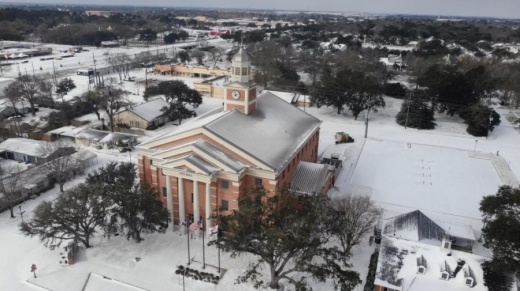Among Katy-area residents affected by Winter Storm Uri was Claudia Yvonne, who said the winter event left her household without power and water for nearly a week. Yvonne and her family, including her elderly mother, spent days struggling to stay warm and cleaning up water that fell throughout the house after a pipe burst in the attic.
“It was horrible,” Yvonne said. “The power was mostly off entirely, and we had to shut off the water after the pipe burst. It was just a horrible situation.”
When the widespread and long-lasting effects the storm was having on residents statewide started coming to light, some critics pointed to Texas’ isolated energy grid as a contributing factor to the prolonged outages that have led many local and statewide leaders to call for change.
“Texans accept a culture of independence and competition—until it fails. Then it’s a test of our culture,” said Bruce Race, a University of Houston professor and director of the Center for Sustainability and Resilience. “This was a shock, an event that, as shocks do, they reveal the weak points in any system.”
Across the service area where CenterPoint Energy provides power, that shock put up to 1.42 million customers in the dark for several days, according to data from the transmission provider. At one point, about 80% of city of Katy residents were without power, Mayor Bill Hastings said.
It took four days before power was restored to nearly all of CenterPoint’s customers, according to data from the transmission provider. Weeks later, many residents, Yvonne included, are still waiting to get much-needed repairs done on their homes.
“People have to realize that this storm didn’t affect us for only a week or two—this is affecting us long term,” she said.
The Energy Reliability Council of Texas, which manages statewide electric power flow and is one of several regulatory bodies under scrutiny following the storm, had to force outages for more than 70 hours statewide—nearly 10 times as long as outages during a 2011 winter storm that led to earlier calls for improvement to the state’s electric system—to avoid a wider, longer-lasting energy shutdown, officials said.
“It created a humanitarian crisis,” said ERCOT board member Jackie Sargent, who has since resigned from the board, during a Feb. 24 meeting.
Unprecedented event
On Feb. 14, every county in Texas was under a winter storm warning, according to the National Weather Service. Not only did Uri bring record-cold temperatures—Houston beat its record for the lowest high temperature with 35 degrees, previously set in 1895—the cold weather lingered for almost a week.
“Part of the problem is when ERCOT does its long-range planning and its forecasting, it’s looking at averaging; it’s looking at trends,” Race said. “It’s not thinking enough about extreme weather events like this.”
However, extreme weather events are becoming more common and more damaging, particularly in Texas, according to federal data. The National Oceanic and Atmospheric Administration found from 1980 to 2020, the U.S. had 285 climate-related disasters causing over $1 billion in damage, 124 of which have occurred in Texas.
Total damage estimates for the February winter storm are not yet known, but the Insurance Council of Texas said it is expected to be the largest claims event in the state’s history.
Waco-based economic research firm The Perryman Group has projected the cost of the storm could top $200 billion, including the costs of lost income and long-term decreases in economic output from businesses that were closed.
In the city of Katy, Hastings said the weather event followed prayers from thousands of children who were hoping to see snow. After it arrived, however, the joy quickly turned into frustration.
“The kids all enjoyed the snow, but it quickly turned into a nightmare for the parents and adults who were responsible for taking care of things when problems began,” Hastings said.
The majority of city residents lost power for several days, Hastings said. In addition, aside from residents who turned off their water because of burst pipes, officials had to shut down the city’s water system for about a day because of complications with one of the city’s water wells.
City officials also responded to a fire in a garage and a fire that burned down the beloved barbecue restaurant Midway BBQ, both of which may have been connected to power issues from the storm.
“In the Gulf Coast of Texas, our houses are not equipped to handle that,” Hastings said. “You think you are prepared, but when you have no power, things get real, real fast.”
About 75% of Katy ISD campuses withstood some form of damage due to the storm, Superintendent Ken Gregorski said in a Feb. 19 video update. Damages to buildings included burst pipes, sheet rock erosion and floor water damage.
Fort Bend County Judge KP George said he, too, sustained substantial property damage to his home from burst pipes.
“In the middle of [the storm], my house got flooded,” George said. “This is fine; I mean hundreds of thousands of people have the same situation, and I’m just saying I’m not on any different level—I’m in the same boat as our citizens.”
'Lack of preparation’
ERCOT was founded in 1970 to manage the power grid that covers most of the state. While it is technically a nonprofit, it is regulated by the Public Utility Commission of Texas, a state agency.
ERCOT did alert generators and distribution partners that the storm would bring “record-breaking demand” to the system, but some lawmakers point out the decisions that set up the grid for potential failure were made years in advance, such as the decision by many generators to not protect facilities from harsh weather conditions—known as winterizing—and not having natural gas plants in a position to ramp up.
“We knew that it was going to get too cold for us to be able to generate enough wind, and there were turbine issues. ... That was not the big story,” said Daniel Cohan, a Rice University professor of civil and environmental engineering. “I think [it was] the lack of preparation to get coal-fired power plants, natural gas-fired power plants [and] nuclear going, having adequate natural gas supply and having that started ahead of time. Really a lack of preparation.”
More than 46,000 megawatts of generation and around 185 generating units were removed from the grid, ERCOT reported in a Feb. 17 statement, which it initially attributed to frozen wind turbines, limited gas supply and pressure, and frozen instrumentation. Most of the lost generation was from natural gas and coal, which dropped 20% of their output between midnight and 3 a.m. Feb. 15, according to federal energy data.
Ongoing response
In the immediate aftermath of the storm, Gov. Greg Abbott made ERCOT reform an emergency item for the 2021 legislative session. In a Feb. 24 tweet, Abbott said he will not allow the session to end until the power grid is fixed, specifically referencing the need for the system to be winterized.
The Legislature began hearings Feb. 25. Former ERCOT CEO Bill Magness, who has since been terminated by the board, told lawmakers the council can make recommendations for how plants should winterize but said generators essentially follow an honor system when it comes to implementing them.
Lawmakers pondered several ways to better enforce winterization, ranging from giving ERCOT the power to issue fines for violations found during spot checks to mandating a certain standard of winterization in state law—a solution Magness said could carry a heavy expense.
Several Harris County officials floated but ultimately moved away from the possibility of leaving the state’s power grid. The commissioners on March 1 unanimously voted to have the county attorney participate in state conversations about improving ties with other power grids.
Fort Bend County commissioners voted unanimously on March 2 to give their support to County Attorney Bridgette Smith-Lawson’s office to “take all appropriate steps to pursue justice through legal action and investigations for our residents against ERCOT all the way to the Supreme Court,” George said.
Within the city of Katy, officials are not requiring any payments for permits for residents who need to make repairs to their homes, Hastings said.
That is good news for residents still grappling with insurance issues and finding trustworthy contractors to work on their homes, said Yvonne, who expects to be dealing with those headaches until her home is fully repaired.
“We are blessed because I know some people who lost everything,” she said. “But there’s another month or two until our home is repaired.”
Although some residents are facing a long road ahead, Katy is a resilient community, Hastings said. Since the storm, city officials have seen neighbors step up to help their neighbors and the residents band together to help those in need.
“Just like every other event, we’re making it through to the other side,” he said. “We’ve all learned some lessons. The next time somebody says ‘arctic front,’ I think we’ll all be a little more prepared for it.”
Laura Aebi, Shawn Arrajj, Matt Dulin, Hunter Marrow, Claire Shoop and Ben Thompson contributed to this report.





